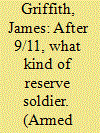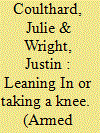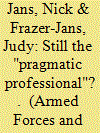|
|
|
Sort Order |
|
|
|
Items / Page
|
|
|
|
|
|
|
| Srl | Item |
| 1 |
ID:
085359


|
|
|
|
|
| Publication |
2009.
|
| Summary/Abstract |
Two concepts, Moskos's institutional-occupational orientations and Meyer and Allen's organizational commitment, were used to develop several hypotheses concerning relationships of soldiers' stated reasons for joining and staying in reserve military service to their stated career intentions and to perceived unit readiness. Survey data were obtained from first-term, junior-ranking enlisted Army National Guard soldiers nationwide at three time periods. Time periods corresponded to different phases of the Iraq conflict- before, during, and after the initial invasion. The number of soldiers at each time period equaled about 7,000 to 8,500. Results suggest material incentives may increase recruitment and retention, yet at the same time, such incentives may not enhance readiness. Rather, incentives fostering normative and affective commitments, such as joining and staying for camaraderie and service to country, were related both to self-reported career intentions and perceived unit readiness.
|
|
|
|
|
|
|
|
|
|
|
|
|
|
|
|
| 2 |
ID:
190782


|
|
|
|
|
| Summary/Abstract |
Less research has examined the extent to which external contexts and factors that influence an organizational member’s life choices also influence their career trajectories within the military, and particularly among those who advance to leadership positions at the General Officer/Flag Officer level. Interviews were conducted with 20 select General Officer/Flag Officers in the Canadian Armed Forces. As part of a secondary analysis of an exploratory qualitative study, we applied a Life Course Theory lens to better understand the intersections between the sociohistorical and cultural context of senior leader development, and the individual choices that the participants made that led to their ascent to their rank. This study provides insight into how the historical time and place, the timing in their lives, the linked lives they share with family, and the degree of agency they maintained over their life choices led participants to “lean in” rather than “take a knee.”
|
|
|
|
|
|
|
|
|
|
|
|
|
|
|
|
| 3 |
ID:
085362


|
|
|
|
|
| Publication |
2009.
|
| Summary/Abstract |
This article examines the extent to which the professional orientation of Australian military personnel has shifted since September 2001. Four dimensions of professional orientation are identified, through analysis of ratings of reasons for serving in surveys conducted across the period 1996 through 2006. Duty/Professionalism represented Moskos's institutional orientation and Pay/Conditions, Development/Enhancement, and Adventure/Variety represented occupational orientation. The professional orientation of Other Ranks is now more pragmatic and more professional, in the sense that Pay/ Conditions and Duty/Professionalism motives are now more important as reasons for serving. Officers, on the other hand, have become less pragmatic and more professional, with Duty/Professionalism motives now dominant in professional orientation and Pay/ Conditions motives now much less important. Development/Enhancement and Adventure/ Variety are now less important for all categories. The article argues that these shifts are due to recent changes to Australia's strategic, social, and economic circumstances and notes the practical and scholarly implications of the results.
|
|
|
|
|
|
|
|
|
|
|
|
|
|
|
|
|
|
|
|
|